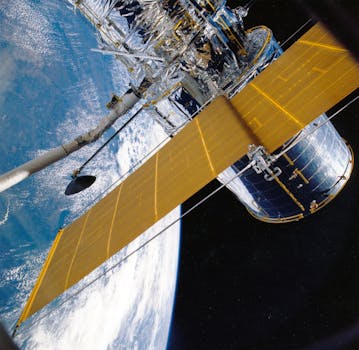From Geostationary to Low Earth Orbit: The Evolution of Satellite Telecommunications in 2023 – Satellite Telecommunications

From Geostationary to Low Earth Orbit: The Evolution of Satellite Telecommunications in 2023 – Satellite Telecommunications
Satellite telecommunications have undergone significant transformations in recent years, with a notable shift from geostationary to low Earth orbit. This evolution has revolutionized the way we communicate, with improved connectivity, increased efficiency, and enhanced services. In this article, we will delve into the advancements in satellite technology and their impact on the industry.
Satellite telecommunications have been around for decades, with the first geostationary satellite launched in 1963. Geostationary satellites, which orbit the Earth at an altitude of approximately 36,000 kilometers, have been the backbone of satellite communications for many years. However, with the advent of new technologies and the increasing demand for faster and more efficient communications, the industry has witnessed a significant shift towards low Earth orbit (LEO) satellites.
The Advantages of Low Earth Orbit Satellites
Low Earth orbit satellites, which orbit the Earth at an altitude of around 160 to 2,000 kilometers, offer several advantages over geostationary satellites. One of the primary benefits of LEO satellites is their lower latency, which enables faster communication speeds. This is particularly important for applications such as real-time video streaming, online gaming, and virtual reality. LEO satellites also have a lower power requirement, which makes them more energy-efficient and cost-effective.
Another significant advantage of LEO satellites is their ability to provide global coverage with a smaller number of satellites. Geostationary satellites, on the other hand, require a larger number of satellites to achieve the same level of coverage. This makes LEO satellites a more attractive option for companies looking to provide global satellite telecommunications services.
The Impact of Satellite Telecommunications on the Industry
The evolution of satellite telecommunications has had a profound impact on the industry. The shift towards LEO satellites has enabled companies to provide faster, more efficient, and more cost-effective services. This has led to an increase in demand for satellite telecommunications, particularly in areas where traditional fiber-optic connectivity is limited or non-existent.
Satellite telecommunications have also enabled the development of new services and applications, such as satellite-based internet of things (IoT) and machine-to-machine (M2M) communications. These services have the potential to transform industries such as agriculture, transportation, and healthcare, by enabling real-time monitoring and communication.
Challenges and Opportunities
Despite the advancements in satellite technology, there are still several challenges that need to be addressed. One of the primary challenges is the issue of space debris, which poses a significant threat to the longevity of satellites in orbit. The increasing number of satellites in orbit also raises concerns about signal interference and spectrum management.
However, these challenges also present opportunities for innovation and growth. The development of new technologies, such as satellite-based solar power and advanced propulsion systems, has the potential to transform the satellite telecommunications industry. The increasing demand for satellite services also presents opportunities for companies to develop new business models and revenue streams.
In conclusion, the evolution of satellite telecommunications from geostationary to low Earth orbit has transformed the way we communicate. The advantages of LEO satellites, including lower latency, lower power requirements, and global coverage, have made them an attractive option for companies looking to provide satellite telecommunications services. As the industry continues to evolve, it is likely that we will see new innovations and applications emerge, which will further transform the way we communicate and interact with each other.




